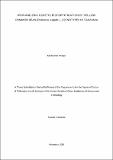| dc.description.abstract | Iron and zinc deficiencies are the global leading micronutrient deficiencies particularly in
developing countries such as Tanzania. Iron deficiency in humans causes anemia, whereas
zinc deficiency leads to compromised immunity, decreased growth rate, and mental
retardation. This study was conducted in the Northern, Eastern, and Southern Highlands of
Tanzania from 2018 to 2020 to address the iron and zinc deficiencies in humans using genetic
biofortification. The approach involved screening common bean genotypes for iron and zinc
contents and the factors (such as phytic acid, and ferritin) that inhibit and or enhance their
availability in the human gut. The genotypes with high seed iron and zinc contents were used
in the genetic biofortification of the consumers’ preferred yellow bean varieties. Field
experiments (involving 99 common bean genotypes) were conducted at TARI-Selian, SUA,
and TARI-Uyole to screen common bean genotypes for seed minerals and yield. The
genotypes were planted following alpha lattice design in three replications each contained
five blocks with 20 plots. Data were recorded for days to 75% flowering, number of
pods/plant, number of seeds/pod, 100 seed weight, and seed yield. Furthermore, the contents
of seed iron, zinc, phosphorus, magnesium, manganese, ferritin, phytic acid, and phytic acid
to mineral molar ratios were determined. Results showed that there were highly significant (P
≤ 0.001) effects between bean genotypes, environments, and genotype by environment
interaction on seed yield, yield related traits, seed iron, and zinc contents. The highest and
stable bean genotypes for seed iron and zinc contents and seed yield were identified. High
phosphorus, magnesium, manganese, and low phytic acid and phytic acid to mineral molar
ratio bean genotypes were also identified. Furthermore, the study developed F2 bean crosses
with a 12.5 - 146.4 % increase in seed iron content and a 1.0 - 53.1 % increase in zinc
content. Seventeen of the developed F2 crosses had a high seed iron content ≥ 70 mg/kg and
seed zinc content ≥ 30 mg/kg, these include BF01, BF04. BF05, BF06, BF08, BF10, BF13,
BF16, BF22, BF24, BF25, BF27, BF29, BF31, BF32, BF33, and BF35. | en_US |

